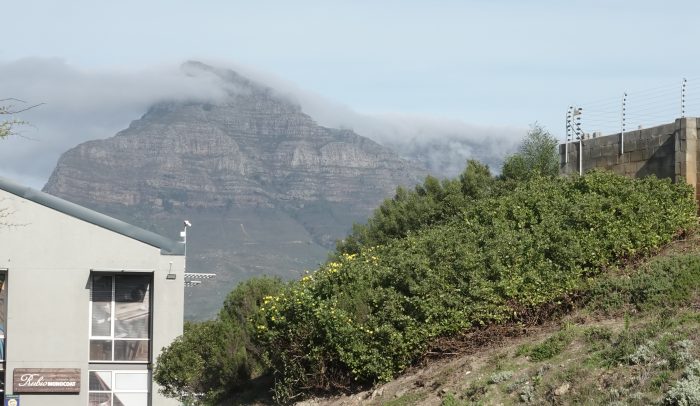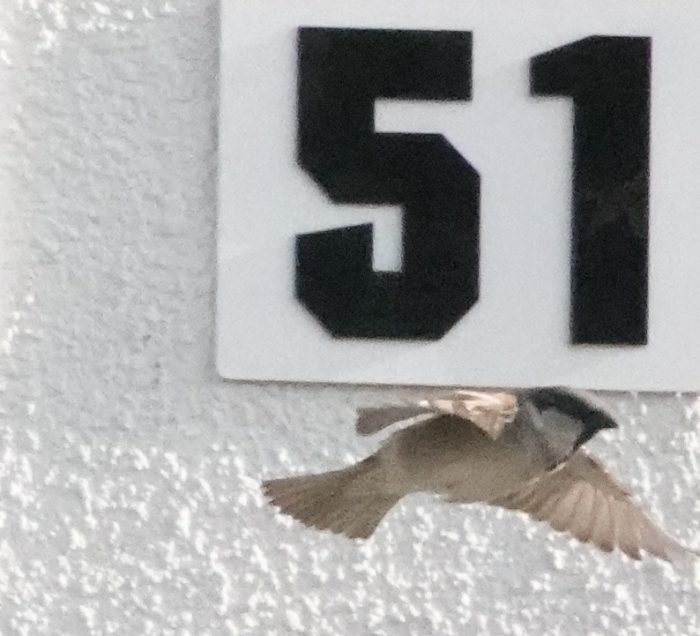We tend to be dismissive of the idea that “development” can be any good for “biodiversity”. Northgate Business Park was clearly designed to be an attractive space to work in, with trees and gardens. One corner of the property has a flood retention dam which holds the run-off of stormwater from the roofs and roads when it rains. A by-product of the investment that has been made in the space outside of the buildings is that it attracts a non-trivial variety of biodiversity. Our interest is primarily in birds, and that is where this blog will mainly focus.
Dieter Oschadleus and I spent an hour wandering around this development looking at the birds at Northgate Business Park. Our one-hour midwinter species list on the morning of 29 June 2024 contained 27 species. A summer list would be longer; it would certainly include, for example, a few swallows. The actual list is near the end of this blog
Habitats
There are three main habitats. The stormwater retention dam, the shrubs on the boundaries and the trees along the roads.
Stormwater retention dam
To find the stormwater retention dam, turn left just inside the entrance, and stop near the picnic table. There is a broad grassy path into this wetland.

Boundary shrubs
The perimeter of the business park farthest from the entrance consist of these shrub-clad embankments.

Tree-lined roads
The third main habitat consists of the trees along the roads. The best roads are the ones opposite the shrubs along the boundaries:

Bird gallery
Here are a few photos of the birds!





At the Northgate Business Park, the Cape Sparrow, top two photos, is far more abundant than the House Sparrow. The photos are evidence of this. There were lots of Cape Sparrow photos to choose from, but there was only one of the House Sparrow, and it was just at the edge of a second-class photo! In most developments of this nature, it is the alien and introduced House Sparrow which is the more common of the two sparrows. These photos are archived in BirdPix, records 283172 and 283173




Cape Weavers preferentially use the fever trees to build their nests at Northgate Business Park. The top left photo shows that this nest is close to the window of someone’s office! The brightly coloured male top right is excitedly displaying, flapping his wings trying to attract a female to inspect his newly constructed nest. The bottom left photo shows that he had success. That is a female Cape Weaver doing her nest inspection. These photos are curated in the section of the Virtual Museum called PHOWN (PHOtos of Weaver Nests). It is record PHOWN 31397


Bird List
Here is our list of 27 species of birds at Northgate Business Park. It is in alphabetical order. It is certainly not exhaustive; if we had spent more time compiling it, we would have seen more species. But the purpose here is to have a list of the common, more-or-less easy to see species. Most of the species have links which take you to the BDI descriptions of them. These species texts have headings Identification, Habitat, Distribution, Breeding, etc.
Blacksmith Lapwing – at the wetland, we saw one pair
Cape Bulbul – anywhere, on the shrubs
Cape Canary – anywhere
Cape Robin-Chat – anywhere, on the shrubs
Cape Sparrow – anywhere, common
Cape Spurfowl – often near the entrance to the wetland
Cape Wagtail – at the wetland, and in and around the gardens
Cape Weaver – anywhere, nests in the fever trees
Cape White-eye – anywhere, on the shrubs
Common Moorhen – in the wetland, mainly on the edges of vegetation
Common Starling – anywhere
Hadada Ibis – anywhere, often fly over
Hartlaub’s Gull – anywhere. many fly over
House Sparrow – on the buildings, and adjacent trees; far less common then Cape Sparrow
Kelp Gull – many fly over
Laughing Dove – anywhere, but not common
Lesser Swamp Warbler – in the reedbeds at the wetland
Levaillant’s Cisticola – on the edges of vegetation at the wetland
Pied Crow – anywhere, many fly over
Red-eyed Dove anywhere, very common
Red-faced Mousebird – – on the shrubs, not common
Red-winged Starling – on the buildings
Rock Dove – on the buildings, abundant
Southern Double-collared Sunbird – in the gardens, not common
Southern Masked Weaver – anywhere, builds its nest in the fever trees
Southern Red Bishop – in the reedbeds in the wetland; it’ll probably breed in spring
White-backed Mousebird – on the shrubs, not common
Most visitors to this development would probably find it hard to believe that an hour’s birding could unearth 27 species of birds at Northgate Business Park. For serious birders, this is a trivial number. But this is a good place for someone who wants to make a start with birding, and who finds the close-on-1000 species in the bird books intimidating. 27 is a big enough challenge, but not overwhelming.
… a significant wetland!
Here is another view of the reedbed at the stormwater retention dam …

The Intaka Island wetland lies 4 km farther away from Cape Town than this one. These small wetlands form a network of stepping stones which enable the birds to move between them.
We found a potential bird ringing site at the stormwater retention dam. Firstly, we will need permission. Secondly, we need to discover if that potential is fulfilled! Thirdly, we anticipate that we will demonstrate bird movements between here and Intaka Island, where bird ringing is undertaken regularly.
… and dragonflies in summer …
We have visited here briefly in summer. We have recorded three species of dragonfly: Blue Emperor, Cape Skimmer, Broad Scarlet. A diligent search will reveal more species!

There is lots of other biodiversity here: frogs, butterflies, moths, reptiles (there must be skinks and chameleons), spiders, … This blog scratches the surface.

Tailpiece
There is only one entrance to the development, and the perimeter is a well maintained security fence. It feels like the kind of place where you can get totally focused on the birds without fear of interference.
Among the tenants at Northgate Business Park is Jonssons Workwear where bird ringers buy their gum boots, and Builders where we buy our bird seed. Giniel Jacobs at Music Experience encouraged us to write this blog on the birds at Northgate Business Park.
And well done to the team who maintain the green part of this business park!

